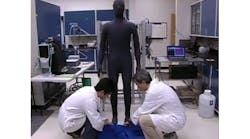Researchers at NIOSH’s National Personal Protective Technology Laboratory (NPPTL) hope to use the new “sweating thermal manikin” to create less burdensome materials and designs for protective clothing used by workers who face the risk of heat stress from prolonged duty in hot and physically stressful work environments.
“We are continually investigating strategies for improving workplace safety and health,” said Dr. Maryann D’Alessandro, Director of NPPTL. “The implementation of the Sweating Thermal Manikin in the NPPTL research portfolio enables us to keep pace with technological advancements.”
Protective clothing manufacturers use a standard testing process to measure the amount of heat transferred through fabric. Based on this kind of test, a number is assigned to the garment called its “Total Heat Loss number.” This number then acts as an indicator of how much heat the fabric of a garment will trap, and thus the potential for heat stress on the employee wearing the garment.
According to Jon Williams, Ph.D., research physiologist at NIOSH, additional testing methods are necessary to take into account various features of the garment itself, which could affect heat retention: pockets, padded knees or elbows and zippers. Furthermore, many workers employ ensembles – several pieces of protective clothing used together – while performing a job task, each with the potential to increase heat build-up.
Testing, Testing
In order to address the possibility of extra padding, various thickness and accessories, NIOSH has traditionally conducted tests to measure Total Heat Loss using volunteer human subjects to measure physiological responses to physical activity while wearing the garments (or ensembles) in a controlled environment. Though this type of testing is invaluable for its real-world applicability and measures actual human reactions, it also has limitations. While all human bodies are similar physiologically, they differ in gender, fitness level and body size. The purchase and use of the “sweating thermal manikin” provides a third and additional method of testing needed in order to determine standardized responses.
“If we want to compare one specific ensemble to another, we don’t want to use human beings, because of individual variations,” said Williams. “So if we want to look at a standardized response, we test all of the different kinds of ensemble types on a sweating thermal manikin producing a response only dependent on the ensembles, not the particularities of the test subject.”
The sweating capability of the manikin helps to calculate evaporative resistance and garment performance in hot environments. The manikin can also “walk” while wearing a particular garment and is set to begin sweating once a certain “skin” temperature is reached. The sweat rate can be controlled by the researcher and is selectable by manikin zone or region. A network of pores over the exterior of the manikin is spaced to uniformly deliver water to the skin surface. A removable fabric skin layer evenly distributes water by drawing the liquid from the manikin surface, which simulates a sweating person.
NIOSH researchers can use this method of testing to accurately compare the fabric features (insulation and evaporation resistance) of one ensemble to another. Because the manikin’s reaction is always constant, the differences seen are attributed to the ensemble characteristics. The use of the sweating thermal manikin as a way to test fabric ensembles, independent of human variations, provides a standardized reference point from which subsequent human variations can be measured or accounted for, making the overall process of measuring heat stress more comprehensive and efficient.
View a video of the sweating thermal manikin here.
